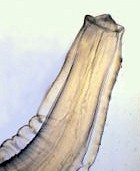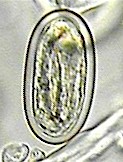Physaloptera is a genus of parasitic roundworms that has dogs, cats and other vertebrates (e.g. pigeons, wild boars, monkeys) as final hosts.
It is found worldwide, but each species has its own distribution, e.g.
- Physaloptera praeputialis is found in many regions of the world.
- Physaloptera rara is found in North America.
- Physaloptera felidis is found in North America.
- Physaloptera pacitae is found in Central America.
 Little is knonw about its prevalence in dogs and cats.
Little is knonw about its prevalence in dogs and cats.
The disease caused by Physaloptera worms is called physalopterosis.
Physaloptera worms do not affect cattle, sheep, goats and other livestock.
Are dogs or cats infected with Physaloptera worms contagious for humans?
- NO. Neither through contact, nor through the feces or the vomit. The reason is that this worm species is not a human parasite. For additional information read the chapter on the life cycle below.
You can find additional information in this site on the general biology of parasitic worms and/or roundworms.
Final location of Physaloptera spp
Predilection sites of Physaloptera worms are the stomach and the small intestine.
Anatomy of Physaloptera spp
Physaloptera spp are medium-sized worms (3 to 4 cm long), whereby females are larger than males. The worm's body is covered with a cuticle, which is flexible but rather tough.
The worms have no external signs of segmentation. They have a tubular digestive system with two openings. They also have a nervous system but no excretory organs and no circulatory system, i.e. neither a heart nor blood vessels. Males have chitinous spicules for attaching to the female during copulation.
The eggs are oval (about 32x50 micrometers), have a thick shell and contain a larva when shed with the feces.
Life cycle and biology of Physaloptera spp

Physaloptera worms have an indirect life cycle with dogs, cats and other vertebrates as final hosts, and various insects (e.g. crickets, cockroaches, beetles) as intermediate hosts. Some species may also infect small vertebrates (e.g. mice, frogs, etc.), as transport (= paratenic) hosts, where they do not complete development to adults, but remain infective. The life cycle of some species is still not completely understood.
Adult female worms attached to the stomach lining of a final host produce eggs that are shed with the feces of the host. The mentioned insects eat these eggs, which release the larvae after digestion. These larvae become encysted in the insect and remain infective. Transport hosts (small rodents, amphibians, etc.) eat these insects and the larvae released in their stomach encyst again somewhere in the host's organism.
When these transport hosts are eaten by dogs and cats, the digested cysts liberate the larvae in the stomach, where they attach to the lining, complete development to adult worms and start producing eggs.
Harm caused by Physaloptera, symptoms and diagnosis
Most infections with Physaloptera worms are benign, remain asymptomatic and recede spontaneously. Massive infections can cause chronic gastritis, bleeding, anemia, dark diarrhea, chronic vomiting, and weight loss.
Gastroscopy is the most reliable diagnostic method. Worms may be found in the vomit of infected pets, especially in puppies and kittens. Eggs are also detected after fecal sedimentation.
Prevention and control of Physaloptera
In endemic regions dogs and cats should be prevented from eating potential intermediate hosts (beetles, crickets, cockroaches) or transport hosts (frogs, rodents, etc.), but this is rather difficult to achieve with hunting or working dogs. In kennels, catteries and boarding houses feces and vomits must be thoroughly eliminated as soon as possible, and appropriate cockroach control should be ensured.
Fenbendazole, ivermectin and pyrantel pamoate are anthelmintic active ingredients known to be effective against Physaloptera infections. However, since most commercial dewormers are not approved for use against Physaloptera, the veterinary doctor has to determine a special treatment regime.
There are so far no true vaccines against Physaloptera worms. To learn more about vaccines against parasites of livestock and pets click here.
Biological control of Physaloptera worms (i.e. using its natural enemies) is so far not feasible.
You may be interested in an article in this site on medicinal plants against external and internal parasites.
Resistance of Physaloptera worms to anthelmintics
So far there are no reports on resistance of Physaloptera to anthelmintics.
This means that if a product fails to achieve the expected efficacy, chance is very high that either the product was unsuited for the control of Physaloptera, or it was used incorrectly.
|
Ask your veterinary doctor! If available, follow more specific national or regional recommendations for Physaloptera control. |